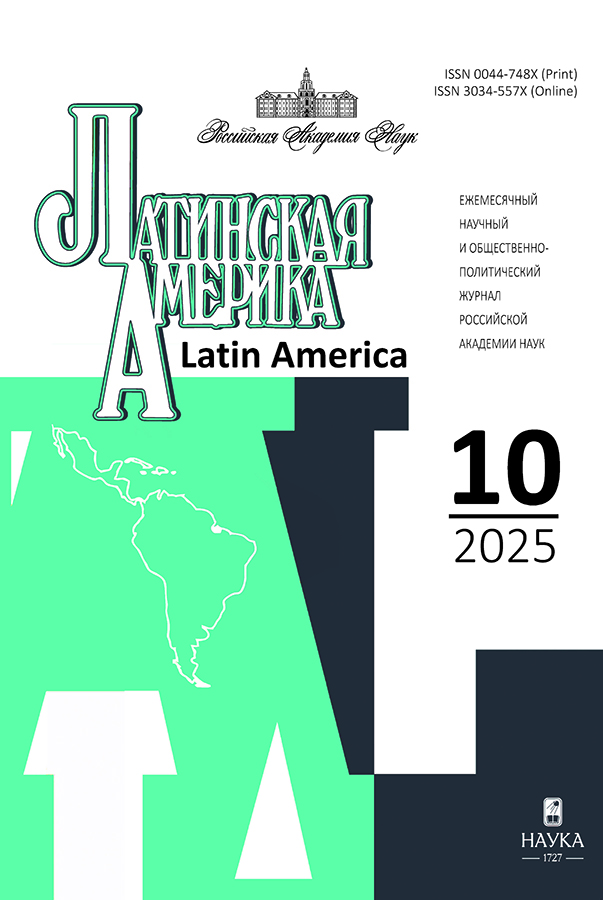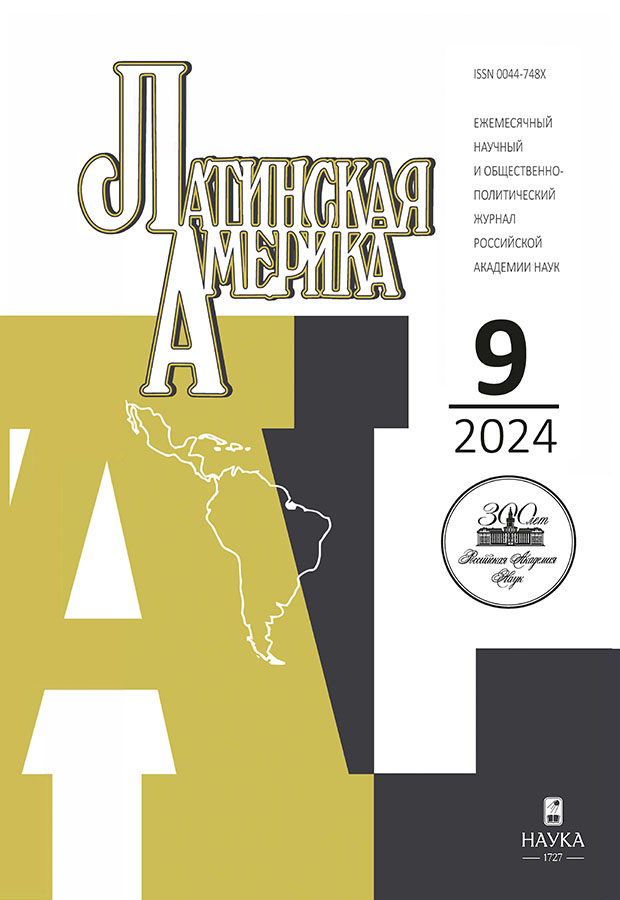Оценка финансового стресса в странах Латинской Америки в периоды глобальных экономических потрясений
- Авторы: Овчаров А.О1
-
Учреждения:
- Нижегородский государственный университет им. Н.И. Лобачевского
- Выпуск: № 9 (2024)
- Страницы: 49-63
- Раздел: Экономика
- URL: https://ter-arkhiv.ru/0044-748X/article/view/668040
- DOI: https://doi.org/10.31857/S0044748X24090048
- ID: 668040
Цитировать
Полный текст
Аннотация
Особенностью современных международных рынков является их подверженность влиянию глобальных и локальных шоков, которые приводят к серьезным негативным последствиям, в частности, к так называемому финансовому стрессу. В данной статье рассмотрены подходы к оценке этого явления и их применение в странах Латинской Америки. Отмечено недостаточное внимание ученых к данной проблематике в контексте исследования региональных факторов нестабильности и финансовых кризисов. Особое внимание уделяется методам конструирования общего показателя финансового стресса. На обширном статистическом материале, относящемся к крупным экономикам Латинской Америки, разработан и апробирован авторский индекс финансового стресса. Расчеты за 2007—2023 гг. позволили идентифицировать три периода нарастания стресса в странах Латинской Америки и зафиксировать его пиковые значения: во время мирового финансового кризиса, пандемии COVID-19 и продовольственного кризиса 2022 г. Выявлен высокий уровень корреляции между финансовым стрессом в США и ситуацией в латиноамериканских государствах, что объясняется их тесными торговыми связями. Кроме того, эмпирически доказана синхронность реакции разных стран Латинской Америки на тот или иной шок.
Ключевые слова
Об авторах
А. О Овчаров
Нижегородский государственный университет им. Н.И. Лобачевского
Email: anton19742006@yandex.ru
ORCID iD: 0000-0003-4921-7780
доктор экономических наук, профессор, главный научный сотрудник кафедры бухгалтерского учета Нижний Новгород
Список литературы
- Tuzcuoglu K. Nonlinear Transmission of International Financial Stress. Economic Modelling, 2024, vol. 139, article 106805. doi: 10.1016/j.econmod.2024.106805. Available at: https://www.sciencedirect.com/science/article/pii/S0264999324001615 (accessed: 20.03.2024).
- Apostolakis G.N., Giannellis N. International Financial Stress Spillovers During Times of Unconventional Monetary Policy Interventions. Journal of Financial Stability, 2024, vol. 72, article 101259. doi: 10.1016/j.jfs.2024.101259. Available at: https://www.sciencedirect.com/science/article/pii/S1572308924000445 (accessed: 20.03.2024).
- Sheng X., Kim W.J., Gupta R., Ji Q. The Impacts of Oil Price Volatility on Financial Stress: Is the COVID-19 Period Different? International Review of Economics & Finance, 2023, vol. 85, pp. 520-532. doi: 10.1016/j.iref.2023.02.006. Available at: https://www.sciencedirect.com/science/article/pii/S1059056023000448 (accessed: 20.03.2024).
- Claessens S., Kose M.A., Terrones M.E. How Do Business and Financial Cycles Interact? Journal of International Economics, 2012, vol. 87, N 1, pp. 178-190. doi: 10.1016/j.jinteco.2011.11.008. Available at: https://www.sciencedirect.com/scien-ce/article/pii/S0022199611001462 (accessed: 20.03.2024).
- Dungey M., Gajurel D. Contagion and Banking Crisis – International Evidence for 2007-2009. Journal of Banking & Finance, 2015, vol. 60, pp. 271-283. doi: 10.1016/j.jbankfin.2015.08.007. Available at: https://www.sciencedirect.com/science/article/pii/S0378426615002186 (accessed: 20.03.2024).
- Agosto A., Ahelegbey D.F., Giudici P. Tree Networks to Assess Financial Contagion. Economic Modelling, 2020, vol. 85, pp. 349-366. doi: 10.1016/j.econmod.2019.11.005. Available at: https://www.sciencedirect.com/science/article/pii/S0264999319310090 (accessed: 20.03.2024).
- Столбов М.И. Индекс финансового стресса для России: новые подходы. Экономический журнал ВШЭ. М., 2019, Т. 23, № 1, сс. 32-60
- Illing M., Liu Y. Measuring Financial Stress in a Developed Country: An application to Canada. Journal of Financial Stability, 2006, vol. 2, N 3, pp. 243-265. doi: 10.1016/j.jfs.2006.06.002. Available at: https://www.sciencedirect.com/science/article/pii/S1572308906000301 (accessed: 20.03.2024).
- González-Hermosillo B. Determinants of Ex-Ante Banking System Distress: A MacroMicro Empirical Exploration of Some Recent Episodes. IMF Working Paper, N 99/33. Available at: https://ssrn.com/abstract=880560 (accessed: 20.03.2024).
- Hardy D.C., Pazarbasioglu C. Determinants and Leading Indicators of Banking Crises: Further Evidence. IMF Staff Papers, 1999, vol. 46, N 3, pp. 247-258. Available at: https://www.imf.org/external/pubs/ft/staffp/1999/09-99/pdf/hardy.pdf (accessed: 20.03.2024).
- Frankel J., Rose A. Currency Crashes in Emerging Markets: An Empirical Treatment. Journal of International Economics. 1996, vol. 41, N 3-4, pp. 351-366. doi: 10.1016/S0022-1996(96)01441-9. Available at: https://www.sciencedirect.com/science/article/pii/S0022199696014419 (accessed: 20.03.2024).
- Caramazza F., Ricci L., Salgado R. Trade and Financial Contagion in Currency Crises. IMF Working Paper, N 00/55. Available at: https://papers.ssrn.com/sol3/papers.cfm?abstract_id=879525 (accessed: 20.03.2024).
- Kauko K. How to Foresee Banking Crises? A Survey of the Empirical Literature. Economic Systems, 2014, vol. 38, N 3, pp. 289-308. doi: 10.1016/j.ecosys.2014.01.001. Available at: https://www.sciencedirect.com/science/article/pii/S0939362514000545 (accessed: 20.03.2024).
- Tölö E., Laakkonen H., Kalatie S. Evaluating Indicator for Use in Setting the Countercyclical Capital Buffer. International Journal of Central Banking, 2018, vol. 14, N 2, pp. 51-111. Available at: https://www.ijcb.org/journal/ijcb18q1a2.pdf (accessed: 20.03.2024).
- Bordo M.D., Dueker M.J., Wheelock D.C. Aggregate Price Shocks and Financial Instability: A Historical Analysis. Economic Inquiry, 2002, vol. 40, N 4, pp. 521-538. doi: 10.1093/ei/40.4.521. Available at: https://onlinelibrary.wiley.com/doi/10.1093/ei/40.4.521 (accessed: 20.03.2024).
- Pariès M.D., Maurin L., Moccero D. Financial Conditions Index and Credit Supply Shocks for the Euro Area. ECB Working Paper, N 1644. Available at: https://papers.ssrn.com/sol3/papers.cfm?abstract_id=2397123 (accessed: 20.03.2024).
- Brave S., Butters R. Monitoring Financial Stability: A Financial Conditions Index Approach. Economic Perspectives. Chicago, 2011, vol. 35, N 1, pp. 22-43.
- Morana C. A New Macro-financial Condition Index for the Euro Area. Econometrics and Statistics, 2024, vol. 29, pp. 64-87. doi: 10.1016/j.ecosta.2021.09.005. Available at: https://www.sciencedirect.com/science/article/pii/S245230622100112X (accessed: 20.03.2024).
- Kazdal A., Korkmaz H.I., Yilmaz M.H. Composing a High-Frequency Financial Conditions Index and the Implications for Economic Activity. Borsa Istanbul Review. Istanbul, 2022, vol. 22, N 4, pp. 769-779. doi: 10.1016/j.bir.2022.01.002
- Kliesen K.L., Owyang M.T., Vermann E.K. Disentangling Diverse Measures: A Survey of Financial Stress Indexes. Federal Reserve Bank of St. Louis Review. St. Louis, 2012, vol. 94, N 5, pp. 369-397.
- Ishrakieh L.M., Dagher L., El Hariri S. A Financial Stress Index for a Highly Dollarized Developing Country: The Case of Lebanon. Central Bank Review, 2020, vol. 20, N 2, pp. 43-52. doi: 10.1016/j.cbrev.2020.02.004. Available at: https://www.sciencedirect.com/scien-ce/article/pii/S1303070120300044 (accessed: 20.03.2024).
- Carlson M., Lewis K., Nelson W. Using Policy Intervention to Identify Financial Stress. Divisions of Research & Statistics and Monetary Affairs Federal Reserve Board, Washington, D.C., 2012, 23 р. Available at: https://www.federalreserve.gov/pubs/feds/2012/201202/201202pap.pdf (accessed: 20.03.2024).
- Balakrishnan R., Danninger S., Elekdag S., Tytell I. The Transmission of Financial Stress from Advanced to Emerging Economies. Emerging Markets, Finance and Trade, 2011, vol. 47 (sup. 2), pp. 40-68. doi: 10.2753/REE1540-496X4703S203. Available at: https://www.tandfonline.com/doi/abs/10.2753/REE1540-496X4703S203?cookieSet=1 (accessed: 20.03.2024).
- Tng B.H., Kwek K.T., Sheng A. Financial Stress in ASEAN-5 Economies from the Asian Crisis to the Global Crisis. Singapore Economic Review. Singapore, 2012, vol. 57, N 2, article 1250013. doi: 10.1142/S0217590812500130
- Cevik E.I., Dibooglu S., Kutan A.M. Measuring Financial Stress in Transition Economies. Journal of Financial Stability, 2013, vol. 9, N 4, pp. 597-611. doi: 10.1016/j.jfs.2012.10.001. Available at: https://www.sciencedirect.com/science/article/pii/S1572308912000617 (accessed: 20.03.2024).
- Louzis D.P., Vouldis A.T. A Financial Systemic Stress Index for Greece. ECB Working Paper, N 1563. Available at: https://papers.ssrn.com/sol3/papers.cfm?abstract_id=1736570 (accessed: 20.03.2024).
- Dahalan J., Abdullah H.B., Umar M. Measuring Financial Stress Index for Malaysian Economy. International Journal of Economics and Financial Issues, 2016, vol. 6, N 3, pp. 942-947. Available at: https://econjournals.com/index.php/ijefi/article/view/2582 (accessed: 20.03.2024).
- Anand B., Paul S., Nair A.R. Time-varying Effects of Oil Price Shocks on Financial Stress: Evidence from India. Energy Economics, 2023, vol. 122, article 106703. doi: 10.1016/j.eneco.2023.106703. Available at: https://www.sciencedirect.com/science/article/pii/S0140988323002013 (accessed: 20.03.2024).
- Stona F., Morais I.A.C., Triches D. Economic Dynamics during Periods of Financial Stress: Evidences from Brazil. International Review of Economics & Finance, 2018, vol. 55, pp. 130-144. doi: 10.1016/j.iref.2018.02.006. Available at: https://www.sciencedirect.com/science/article/pii/S1059056016302234 (accessed: 20.03.2024).
- Fernandez R., Guizar B.P., Rho C. A Sentiment-based Risk Indicator for the Mexican Financial Sector. Latin American Journal of Central Banking, 2021, vol. 2, N 3, article 100036. doi: 10.1016/j.latcb.2021.100036. Available at: https://www.sciencedirect.com/science/article/pii/S2666143821000168 (accessed: 20.03.2024).
- Park C.-Y., Mercado R.V. Determinants of Financial Stress in Emerging Market Economies. Journal of Banking & Finance, 2014, vol. 45, pp. 199-224. doi: 10.1016/j.jbankfin.2013.09.018. Available at: https://www.sciencedirect.com/science/article/pii/S0378426613003865 (accessed: 20.03.2024).
- Martínez J.F., Oda D. Characterization of the Chilean Financial Cycle, Early Warning Indicators and Implications for Macro-prudential Policies. Latin American Journal of Central Banking, 2021, vol. 2, N 1, article 100024. doi: 10.1016/j.latcb.2021.100024. Available at: https://www.sciencedirect.com/science/article/pii/S2666143821000041 (accessed: 20.03.2024).
- Shim I., Shin K. Financial Stress in Lender Countries and Capital Outflows from Emerging Market Economies. Journal of International Money and Finance, 2021, vol. 113, article 102356. doi: 10.1016/j.jimonfin.2021.102356. Available at: https://www.sciencedirect.com/science/article/pii/S026156062100005X (accessed: 20.03.2024).
- Statistical Review of World Energy 2023. Available at: https://www.energyinst.org/data/assets/pdf_file/0004/1055542/EI_Stat_Review_PDF_single_3.pdf (accessed: 20.03.2024).
- St. Louis Fed Financial Stress Index. Available at: https://fred.stlouisfed.org/series/STLFSI4 (accessed: 20.03.2024).
- Hunger in Latin America: whole continent is on the move, warns WFP. UN News. 14.06.2022. Available at: https://news.un.org/en/story/2022/06/1120312 (accessed: 20.03.2024).
- Espinoza M., Sepúlveda N. La violenta alza de los alimentos en los supermercados: algunos productos subieron hasta 90% en un año. CIPER. 14.04.2022. Available at: https://www.ciperchile.cl/2022/04/14/la-violenta-alza-de-los-alimentos-en-los-supermercados-algunos-productos-subieron-hasta-90-en-un-ano/ (accessed: 20.03.2024).
- Chile announces $3.7 billion recovery plan to aid struggling economy. Reuters. 07.04.2022. Available at: https://www.reuters.com/world/americas/chile-announces-37-billionrecovery-plan-aid-struggling-economy-2022-04-07/ (accessed: 20.03.2024).
- Овчаров А.О. Финансовые кризисы и финансовое заражение в странах Латинской Америки. Мировая экономика и международные отношения. М., 2023, Т. 67, № 2, сс. 113-122 [Ovcharov A.O. Finansovye krizisy i finansovoe zarazhenie v stranah Latinskoj Ameriki.
- mezhdunarodnye otnosheniya]. Moscow, 2023, vol. 67, N 2, pp. 113-122 (In Russ). doi: 10.20542/0131-2227-2023-67-2-113-122
Дополнительные файлы










